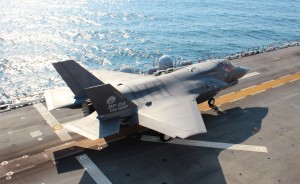2012-07-26 An overview of the F-35 program from the standpoint of the pilots in the program is provided in the videotape of the session at the Air Show on July 10, 2011
As readers of Second Line of Defense know, we have spent considerable time with F-35 test pilots and F-22 pilots.

We have as well interviewed Colonel Arthur Tomassetti who was one of the panelists.
He is the vice commander of the 33rd Fighter Wing, Air Education and Training Command, Eglin Air Force Base, Fla. The 33rd Fighter Wing serves as the home to the Joint Strike Fighter Integrated Training Center, providing pilot and maintenance training for nine international partners.
In the video, the pilots discuss the aircraft and its performance. It is fifth generation in more ways than its stealth characteristics; as we observed aboard the USS Wasp a F-18 pilot in landing the B stated that “this is the easiest aircraft to fly I have ever been in.”
For the pilots, the cockpit is a game changing experience and will shape 5th generation warfare across the combat enterprise.
As Michael Skaff, the Lockheed expert on developing and building the cockpit has put it:
Skaff: I was an F-16 pilot out of the Air Force Academy. I was prior enlisted, and I’ve been with Lockheed Martin for about 23 years working on the F-35 cockpit since ’95. I flew out of MacDill, Shaw, and Luke during the Cold War.
SLD: The cockpit enables the pilot to function as a tactical decision maker, which makes lots of sense from a fighter pilot perspective. So what is it about the basic cockpit that you get with the basic plane that makes this plane different?
Skaff: When we designed the cockpit, we started with a design philosophy called “return the pilot to the role of tactician.” And the reason we did that was because while the F-16 I flew and the F-15 and the Gripen the Rafale, are all good airplanes, managing their sensors overloads the pilot.
Rather than doing tactical things, the pilot spends his time controlling and tilting radars. So we said, “We’ve got to get away from that. We’ve got to return this pilot to the role of tactician and let advanced processors and fusion do the kinds of things that they can do really well that just burden the pilot.”
In other words, let computers do what computers do best and let pilots do what pilots do best.
Computers can do algorithmic functions extremely well and fast. Pilots do heuristic ‘thinking’ very well, but only when they have time to do it. We’ve got to return time to the pilot.”
And so with that philosophy, we wanted to make sure that the airplane gave the pilot situational awareness and a manageable workload.
SLD: So you’re getting a basic cockpit for each platform in a fleet of cockpits built into the fleet. And this cockpit is built on a man machine interface and this man machine interface gives you the second capability, which is the fusion “engine”, which brings together and integrates the core combat systems on the F-35. So talk a little bit about the fusion “engine” and the relationship to the fusion “engine” to the cockpit.
Skaff: The fusion “engine” is the heart of the airplane and is the core capability enabler which gives the pilot the situational awareness and the manageable workload.
It is gathering all of this information that is external to the airplane through the sensors fusing, correlating them and giving the pilot a single picture that’s very easy to interpret.
For our report on the baseline F-35 coming to Yuma Air Station in 2013
F-35 Pilots and the F-35: A Discussion at Farnbourgh Air Show 2012 from SldInfo.com on Vimeo.


